Hazelnuts
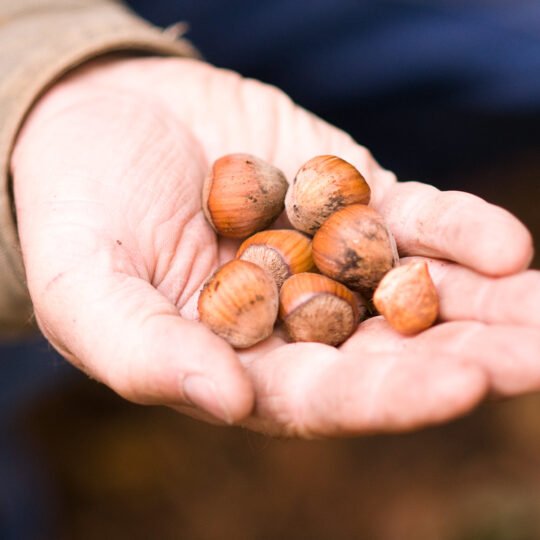
Importance of Hazelnuts to Oregon
There are so many hazelnuts grown in Oregon that they are the state nut. The nuts are grown by more than 1,300 farms in Oregon. Those farms grow 100% of the hazelnuts in the United States. The countries Italy and Turkey are the only places that grow more hazelnuts than Oregon. In 2020, Oregon grew 63,000 tons of nuts, which were worth 132 million dollars. That made them the 10th most valuable agricultural commodity in the state that year.1
History of Hazelnuts
Some people call hazelnuts filberts. They grow wild in parts of Europe and Asia. They have been eaten since prehistoric times. Burned hazelnut shells have been found that are from 8000-2700 BCE. They were found in Sweden, Denmark, and Germany. A Chinese book from 2838 BCE says that hazelnuts were a sacred food in China.
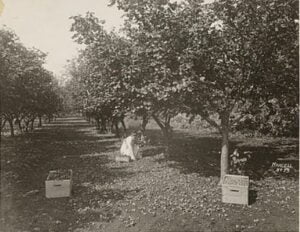
1910, Oregon Historical Society Research Library, Digital Collections, OrgLot78_B5F5_018
Sam Strictland planted the first hazelnut tree in Oregon in 1858. It was in Scottsburg. A man named Felix Gillet was important to Oregon hazelnuts. He brought new varieties to the state. George Dorris started the first hazelnut orchard in Oregon. He planted 50 Barcelona trees in 1903. The trees were bought from Felix Gillet. His orchard is in Springfield. It now has 9,250 trees.2

Willamette Hazelnut Orchard, 2017, Image by Bonnie Moreland on Flickr
George Dorris also had a nursery and sold trees to farmers. More than half the hazelnuts in Oregon today might be from that nursery stock3.
Hazelnut Varieties
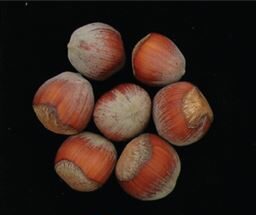
Barcelona
Barcelona is the most common variety grown in Oregon. More than 60% of the hazelnut acres in Oregon are Barcelona. They have a strong flavor and round nut that processors prefer. Because it has been grown for so long, it is the variety that others are compared to. A problem with Barcelona is that they are more likely to get Eastern filbert blight.
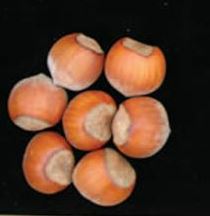
Jefferson
Jefferson trees are resistant to Eastern filbert blight and are a common variety. The nut they produce is larger than many others. The nuts are harvested in early to mid-October. Nuts from Jefferson trees are good for many different uses.4
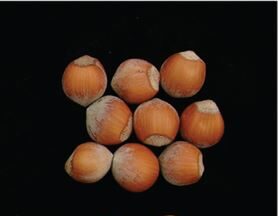
Yamhill
Yamhill hazelnuts are harvested in early October. They are also resistant to Eastern filbert blight. This variety produces many nuts. They are a smaller tree, compared to varieties like Barcelona.5
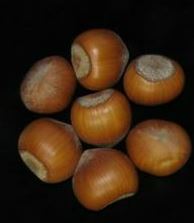
York
York is a pollinizer variety and makes a lot of pollen. It is resistant to Eastern filbert blight. This makes it a good variety to plant with other tree varieties. It is also resistant to bud mite, which can damage hazelnuts. York nuts are harvested in early October.6
Life Cycle of a Hazelnut
Hazelnuts naturally grow like a bush or shrub. In Oregon, farmers grow hazelnuts as a tree, with one trunk. This means that farmers have to make them grow into a tree by pruning them every year.
Hazelnut orchards are usually planted in early winter. The trees are planted in straight rows with enough space to grow into large trees. The trees can grow up to 40 feet tall. Sometimes farmers will plant them closer together and then remove some trees when they get too big.
After they are planted, it will be close to four years before nuts are harvested. The trees don’t grow very many nuts the first few years of life. Healthy hazelnut trees can grow nuts for 40-50 years.
Bloom and Pollination
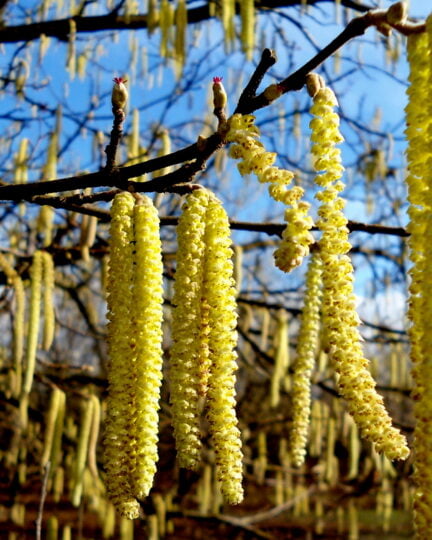
Male Hazelnut Blossom
The male flowers on a hazelnut are long, yellow catkins.

Female Hazelnut Blossom
The female hazelnut flowers are tiny red, purple flowers.
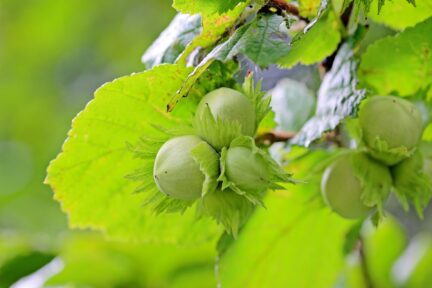
Unripe Hazelnut
Each nut has a protective husk. The nuts mature at the end of summer. They are green while growing, but become brown by harvest time.
Hazelnut Harvest
Pests and Diseases
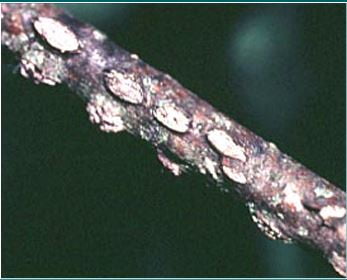
Eastern Filbert Blight
Eastern filbert blight is one of the main hazelnut diseases. Infected trees produce less nuts than healthy trees. Branches infected with the disease can die during the summer. Many farmers take out trees with Eastern filbert blight and plant new trees. Many new varieties are resistant to the disease.
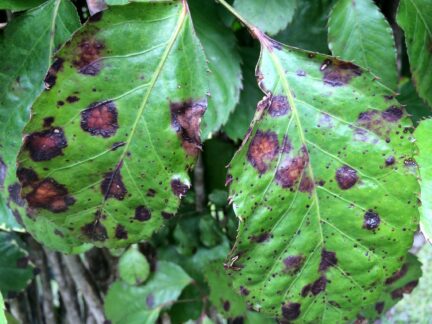
Bacterial Blight
Bacterial blight is the second-worst disease in Oregon hazelnuts. Years with lots of rain cause the disease to get worse. The disease can kill young trees if it gets in the trunk bark. It can kill the twigs of older trees. Less twigs and buds mean less nuts from the tree.
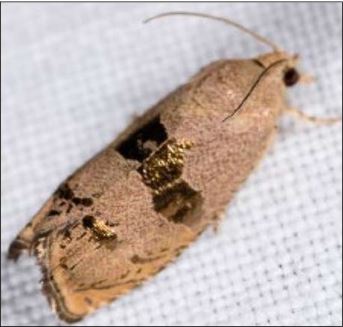
Filbertworm
Filbertworm is the worst insect in hazelnuts. The insects eat the nuts as they grow. This means there are less nuts to harvest. The filbertworm does the most damage during the summer.
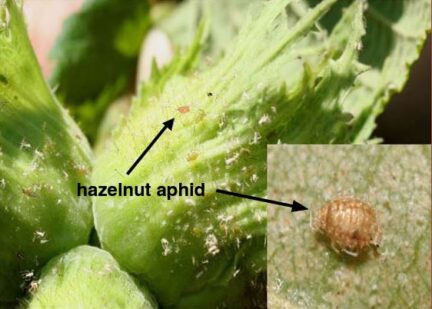
Aphids
The filbert aphid and hazelnut aphid both damage hazelnuts. The aphids suck juice out of the leaves. They can also leave mold on the leaves. The mold means less leaf surface for the sun to shine on. Filbert aphids have been found since 1903 in the United States. Hazelnut aphids have been found in Oregon since 2003.8
Uses for Hazelnuts
Fun Facts About Hazelnuts!
- The hazelnut became Oregon’s official State Nut in 1989
- In 2018, Oregon grew enough hazelnuts to feed all Oregonians one serving every single day of the year – and then some!
- June 1 is World Nutella Day
- Chocolate is the favorite flavor people want to eat with hazelnuts9
Vocabulary Terms
Catkin
The male part of hazelnut flowers.
Climate
Temperature, rain, and wind at a location over a period of years.
Commodity
A product, good or service that is sold at a price.
Monoecious
A plant that has female and male flowers.
Nursery Stock
Plants grown in nurseries to be sold.
Pollinizer
A tree variety that makes pollen to pollinate other trees in the orchard.
Processor
A machine used to dry and clean nuts.
Pruning
Cutting off and removing branches.
Resistant
Strong and able to not get infected by disease.
